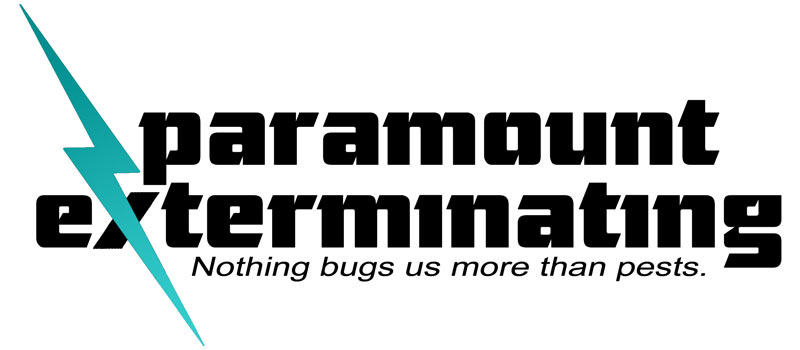CALL US TODAY! 800-273-6050
WHAT TYPE OF FLY OR MOTH IS IT?
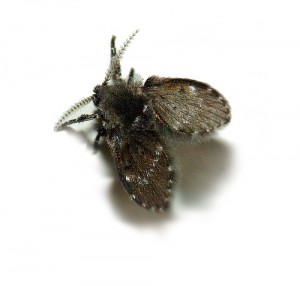 Name: Drain Fly (Psychodidae)
Name: Drain Fly (Psychodidae)
Appearance: Drains flies are easily distinguishable by their small size and the fuzzy hairs on their wings. They average 1/16th inch in length and are generally light grey to tan in color. They are also commonly known moth flies because of their coloring, wing shape, and visible antennae.
Habit: Drain flies thrive in areas with high moisture levels, and are commonly seen inside of the home hovering over sink drains or over floor drains. They are often seen in kitchens, bathrooms, and basements. Outdoors they are often seen near damp mulch or other sources of decay like old wood logs or compost heaps. They use these areas of decay to feed and reproduce.
Diet: Decaying organic matter.
Reproduction: Drain flies with most often lay their eggs directly on decaying organic matter, allowing their young to feed after hatching. This will commonly occur in kitchen sink drains because of the excess food matter that get left inside of the drain after cleaning dishes. Adult drain flies usually only survive an average of two weeks after emerging, but because of their constant breeding they are often replaced by new adults almost immediately.
 Name: Fruit Fly (Drosophilidae)
Name: Fruit Fly (Drosophilidae)
Appearance: Adult fruit flies are generally 1/8th inch in length, with a light tan colored body and distinct red eyes. They have one pair of translucent wings.
Habit: Fruit flies tend to be seen outdoors near food and garbage areas during the summer months. They can survive indoors all year round. They are surprising strong fliers and will cover considerable distances to find a food source.
Diet: Fruits/Vegetables, soft organic matter.
Reproduction: Like the drain fly, fruit flies require moisture and organic material for survival. Fruit flies go through four life stages, each lasting a week to a month depending on environmental conditions and temperatures. Adults flies can survive up to a month.
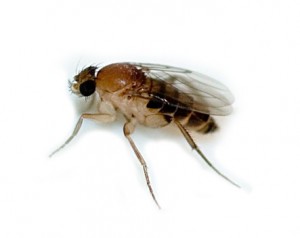 Name: Phorid Fly (Phoridae)
Name: Phorid Fly (Phoridae)
Appearance: Distinguishable by their humpbacked appearance, Phorid flies are generally tiny, averaging 1/16th inch in length and dark brown to tan in color.
Habit: Phorid flies can be difficult to identify with the naked eye, and are often confused for other small flies like drain flies or gnats. A distinguishing trait is their comparatively short flight patterns. Since they are not strong fliers, Phorid flies are often seen “running” along surfaces rather than flying.
Diet: Dependent on specific species. Most will feed on various decaying organic material, while their preference is for decaying animal material. Because of this they have gotten common name “coffin flies”.
Reproduction: Phorid flies generally breed on decaying organic material. This can be anything from rotting fruit to animal carcasses. Their life cycle can last over a month in the right conditions. Like most flies, they go through the standard four-phase life cycle; egg, larval, pupal, and adult phase.
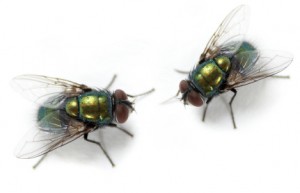 Name: Bottle Fly (Phaenicia sericata)
Name: Bottle Fly (Phaenicia sericata)
Appearance: Bottle flies are a shiny green or blue color, and larger than most other flies. These flies are relatively common and are often seen hovering above garbage and sanitation areas.
Habit: Bottle flies are known to transit a variety of diseases that can be dangerous to humans. This occurs because flies often land on rotting organic material or waste products and then land on food or other items that will eventually be consumed or handled. Bottle flies appearing inside of the home can often mean that an animal may have died near by since they breed in soft organic material.
Diet: Scavenger diet, consuming decaying organic matter. Bottle flies will often pollinate flowers also.
Reproduction: Female bottles can lay over 150 eggs at a time. These eggs mature into larvae within 2 to 8 days depending on the temperature and then seek a pupation site. Pupation can tack 2-3 weeks, with adults eventually emerging to continue the mating cycle.
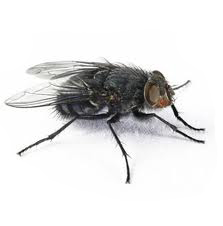 Name: Cluster Fly (Pollenia rudis)
Name: Cluster Fly (Pollenia rudis)
Appearance: Cluster flies are large flies, and slightly larger in size than house flies. They are recognizable by their grey markings, their size, and by the gold hairs on their thorax and underside.
Habit: Cluster flies have been given their name as a result of the tendency of resting or “clustering” on the sunny sides of homes or other structures. They are mostly prevalent during the autumn months and can last throughout the winter. Cluster flies are overwintering pests, which means that they like to spend their winters indoors, often in attics or inside of wall voids.
Diet: Herbivore diet; organic matter. Sap, fruits, flowers, feces and animal meat are all attractants for cluster flies.
Reproduction: Adult flies lay their eggs in the soil, and the larvae are parasitic on earthworms. Reproduction takes place outdoors as a result.
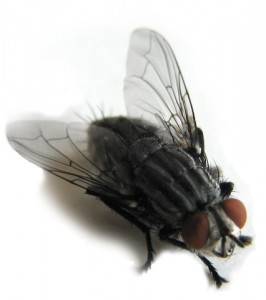 Name: Flesh Fly (Sarcophagidae)
Name: Flesh Fly (Sarcophagidae)
Appearance: Greyish color, with four black stripes that run along its thorax. They are around 5/8ths inches in length, and have large, red compound eyes.
Habit and Habitat: Flesh flies get their common name from breeding in decaying organic material like carrion and feces. This allows for their larvae to have a food source upon hatching.
Diet: Scavenger-like diet; will eat almost anything.
Reproduction: Female flesh flies carry their eggs on them until they are ready to hatch. When the time comes, the female will leave her larvae on an appropriate food source so that they can feed. This process will last only a few days before the larvae are ready for the pupal stage. The pupal stage will last a few days to a week depending on the temperature and environmental conditions, with adult flies eventually emerging.
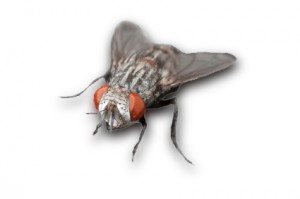 Name: House Fly (Musca domestica)
Name: House Fly (Musca domestica)
Appearance: House flies are generally a greyish color, with black stripes running down its back. They are usually under ¼ inch in length and are commonly seen inside of the home. They have large compound eyes that allow for them to see in all directions to avoid harm.
Habit and Habitat: House flies are often seen in various locations around the home, but are most commonly found in kitchens, bathrooms, and areas where trash is stored. They fly around in search of food and land frequently, creating health concerns for people. House flies will land on contaminated food or waste materials, and then quickly land on other surfaces like kitchen counters and even prepared food. House flies are known to spread a variety of pathogens that can cause diseases like tuberculosis and malaria.
Diet: Scavenger-like diet; House flies will feed on a variety of food sources like human and animal food products, decaying organic matter, and waste materials.
Reproduction: The female house fly can produce an average of 75 to 100 eggs per sitting. These eggs hatch quickly, especially in warmer temperatures, and it only takes around ten days for the newly hatched larvae to become an adult fly. Females will lay their eggs on decaying organic material so that the larvae have a food source upon hatching. This is why they are often found breeding in garbage areas or areas with excessive waste materials.
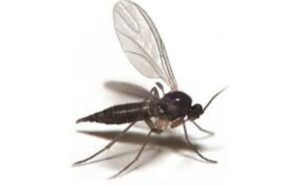 Name: Fungus Gnats
Name: Fungus Gnats
Appearance: House flies are generally a greyish color, with black stripes running down its back. They are usually under ¼ inch in length and are commonly seen inside of the home. They have large compound eyes that allow for them to see in all directions to avoid harm.
Habit and Habitat: House flies are often seen in various locations around the home, but are most commonly found in kitchens, bathrooms, and areas where trash is stored. They fly around in search of food and land frequently, creating health concerns for people. House flies will land on contaminated food or waste materials, and then quickly land on other surfaces like kitchen counters and even prepared food. House flies are known to spread a variety of pathogens that can cause diseases like tuberculosis and malaria.
Diet: Scavenger-like diet; House flies will feed on a variety of food sources like human and animal food products, decaying organic matter, and waste materials.
Reproduction: The female house fly can produce an average of 75 to 100 eggs per sitting. These eggs hatch quickly, especially in warmer temperatures, and it only takes around ten days for the newly hatched larvae to become an adult fly. Females will lay their eggs on decaying organic material so that the larvae have a food source upon hatching. This is why they are often found breeding in garbage areas or areas with excessive waste materials.
FLY & MOTH FACTS
Pest Entry: Flies will often enter through open windows and doors during the summer months, but can enter through any small crack or entry way into the home because of their small size.
Environment: For the most part, flies prefer to live in areas with poor sanitation and/or rotting food, like garbage areas. They will often feed on garbage and lay their eggs on rotting food. They will however make their way indoors to search for food, and can even live and breed inside of the home.
Reproduction: The life span of a fly generally varies from one week to two months depending on the species and its environment. Flies will often lay their eggs on decaying material so their hatchlings can use it for food. The amount of eggs laid by a female is dependent on the species, but many lay around 75 to 100 eggs per batch, with multiple batches.
Health/Damage Concerns: Flies are known to spread disease rapidly due to their preference for filth and decaying material. They will often land on rotting garbage, and then quickly land on human food without anyone knowing. The microorganisms that they carry can cause every thing from Salmonella and dysentery, to tuberculosis and hepatitis.
Home Remedies: The most crucial step in controlling these pests is proper sanitation. Flies are generally attracted to the strong odors of filth or decaying material, and are usually eliminated by removing whatever it is they are attracted to. A sudden rise in fly activity in a sanitary location is usually the sign that decaying material is near by.
Why Families and Businesses Choose Paramount
- Faster Service – Get your services scheduled quickly and on YOUR time. No one wants to wait weeks for treatment, and we get that.
- Local and Reliable – We have pest control technicians in Union City, Jersey City, Hoboken, Weehawken, North Bergen, and Hudson County everyday to assist our customers at a moments notice!
- More Efficient – We get things done right the first time, saving you time, money, and frustration.
- Better Tools – Our technicians only use the best products available on the professional market making treatments more effective and longer lasting.
- Better variety of treatment methods – Including green treatments and baiting programs.
- More Experience – We’ve been defeating all types of pests since 1930, and have the most experienced technicians in the industry.
HOURS OF OPERATION
Monday – Friday: 8am – 4pm
Saturday: 8am – 2pm
Sunday: Closed
• 24-Hour Emergency Service Available •
• Free Evaluations •
Proudly Serving Jersey City, West New York, Guttenberg,
Hoboken, Weehawken, Secaucus, & All of Hudson County
CALL US TODAY
Union City, NJ Rutherford, NJ Ridgewood, NJ
(201) 865-7799 (201) 945-7066 (973) 423-0234
Newark, NJ NJ Toll Free Jersey City, NJ
(973) 242-2212 (800) 273-6050 (201) 435-5900
